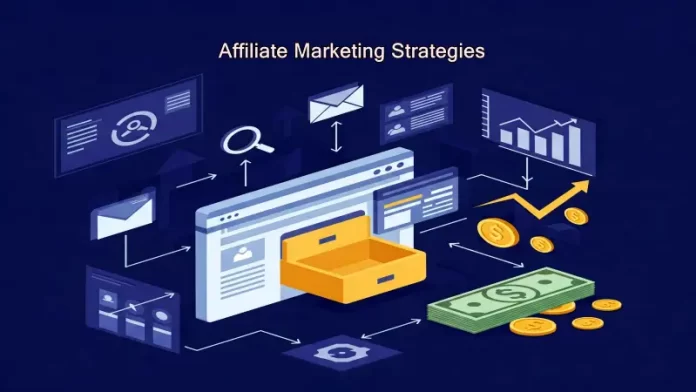Table of Contents
25 Proven Affiliate Marketing Strategies for Real Results
So, you’re diving into the world of affiliate marketing, or maybe you’re already in it but feeling kinda stuck? Yeah, we hear you. It’s often painted as this easy path to passive income just slap some links on a page and watch the cash roll in, right? If only! Truth be told, successful affiliate marketing takes smarts, effort, and the right strategies.
There’s a ton of noise out there, loads of ‘gurus’ selling dreams. But what actually works? What separates the affiliates earning pennies from those building a sustainable income? It boils down to consistent effort, understanding your audience, and implementing tactics that deliver genuine value. Forget the magic bullets; lets talk real-world affiliate marketing strategies that can help you build momentum and, crucially, earn.
We’ve compiled 25 strategies, blending foundational principles with newer tactics. No fluff, just actionable stuff you can start thinking about today. Ready to level up your affiliate game? Lets get into it.

Foundational Strategies: Building Your Base
1. Niche Down Like You Mean It: Stop trying to appeal to everyone. Seriously. The riches are in the niches, as they say. Pick a specific topic or audience you genuinely understand or are passionate about. Think ‘vegan baking for beginners’ not just ‘baking’. This allows you to become a trusted authority and attract a dedicated audience thats more likely to convert.
2. Know Your Audience Inside Out: Who are you talking to? What are their problems, desires, questions, and pain points? Create an audience persona. Understanding this deeply allows you to tailor your content and product recommendations perfectly, making them far more relevant and effective.
3. Build an Actual Website/Blog: While you can do affiliate marketing without one, having your own platform (like a WordPress blog) gives you control, builds credibility, and serves as your central hub. It’s your piece of online real estate treat it like prime property!
4. Prioritize High-Quality Content: This is non negotiable. Whether it’s blog posts, videos, or podcasts, your content must be valuable, informative, engaging, and solve a problem for your audience. Thin, spammy content just doesn’t cut it anymore. Google hates it, users hate it, its a fast track to failure.
5. Choose the RIGHT Affiliate Programs: Don’t just sign up for everything. Partner with programs and promote products that are genuinely relevant to your niche, high quality, and that you can stand behind. Promoting junk will trash your reputation fast. Consider commission rates, cookie duration, and merchant support too.
Content-Driven Strategies: Engaging Your Audience
6. Write In-Depth, Honest Product Reviews: Go beyond summarizing the sales page. Buy the product (if feasible), use it thoroughly, and share your real experience – pros and cons. Photos, videos, personal anecdotes… they all add immense credibility. People trust authentic reviews.
7. Create Comparison Posts: “Product A vs. Product B” articles are incredibly popular and convert well. Help your audience make informed decisions by objectively comparing features, pricing, performance, and suitability for different needs. Structure these clearly with comparison tables.
8. Develop How-To Guides & Tutorials: Show your audience how to use the products you recommend to achieve a specific outcome. For instance, a tutorial on using a specific software you’re affiliated with, or a guide on achieving a fitness goal using certain equipment. This demonstrates value beyond just selling.
9. Build Resource Pages: Compile a list of the essential tools, products, or services you recommend for your niche (e.g., “Best Gear for Starting a Podcast“). These pages become go-to references for your audience and can generate significant affiliate income over time. Keeping these pages updated are key.
10. Create Engaging Video Content: Video is huge. Think YouTube reviews, unboxings, tutorials, or even short clips for social media (like TikTok or Instagram Reels). Seeing a product in action or hearing your perspective directly can be very persuasive.
Traffic & Promotion Strategies: Getting Eyeballs
11. Master SEO Basics (At Least): You need traffic, and search engine optimization (SEO) is a powerful way to get free, targeted visitors. Learn about keyword research (finding terms your audience searches for), on-page optimization (using keywords in your content), and building backlinks (getting other sites to link to you). It’s a long game, but pays off handsomely.
12. Build an Email List (Seriously, Do It!): Your email list is arguably your most valuable asset. Offer a compelling reason for people to subscribe (a free guide, checklist, webinar) and then nurture that list with valuable content and relevant affiliate offers. Unlike social media, you own your list.
13. Leverage Social Media Strategically: Don’t just blast links. Choose platforms where your audience hangs out (Pinterest for visual niches, LinkedIn for B2B, Instagram/TikTok for lifestyle). Share valuable content, engage with followers, and then weave in affiliate recommendations naturally. Building community first works best.
14. Consider Paid Advertising (Carefully): Platforms like Google Ads or Facebook Ads can drive targeted traffic quickly, but require careful budgeting, targeting, and tracking. It’s not usually recommended for absolute beginners until they understand their numbers (conversion rates, cost per acquisition). Running ads, careful budgeting is key.
15. Guest Blogging on Relevant Sites: Write valuable articles for other websites in your niche, including a link back to your own site (or sometimes even a relevant affiliate link, if allowed). This builds authority, drives referral traffic, and helps with SEO.
Optimization & Advanced Techniques
16. Track Your Affiliate Links: How do you know what’s working if you don’t track? Use tracking tools (many affiliate platforms have basic tracking, or use tools like Voluum or RedTrack for more advanced needs) to see which links get clicked and which ones convert. Data tells you where to focus your efforts.
17. A/B Test Everything: Don’t assume you know what works best. Test different headlines, call-to-action buttons, email subject lines, landing page layouts, even the placement of your affiliate links. Small tweaks can sometimes lead to big improvements in conversion rates. The results speaks for itself sometimes.
18. Optimize Your Calls-to-Action (CTAs): Make it clear what you want people to do. Use action-oriented language (“Learn More,” “Get Started Today,” “Check Current Price”). Make your CTA buttons stand out visually. Don’t be shy, but don’t be obnoxious either.
19. Build Relationships with Affiliate Managers: These folks can be incredibly helpful. They can provide insights, negotiate better commission rates (once you prove your value), offer exclusive promotions, and keep you updated on new products. Its key to build strong relationship.
20. Diversify Your Income Streams: Don’t rely on just one affiliate program or product. Promote a mix of relevant offers. This protects you if one program changes its terms, closes down, or a product becomes outdated. Also consider mixing high-ticket and low-ticket items.
21. Offer Custom Bonuses: Sweeten the deal! Offer an exclusive bonus (like your own ebook, checklist, video course, or personal support) to people who purchase through your affiliate link. This gives them an extra reason to buy from you instead of someone else. Make sure the bonus is genuinely valuable.
22. Focus on Mobile Optimization: A huge chunk of web traffic is mobile. Ensure your website, landing pages, and emails look great and function perfectly on smartphones and tablets. Slow loading times or awkward formatting on mobile will cost you sales.
23. Use Link Cloaking (Wisely & Transparently): Tools can shorten long, ugly affiliate links and sometimes help with tracking. However, be transparent – don’t try to trick people into clicking. Some platforms (like Amazon Associates) have specific rules about link cloaking, so always check the terms of service.
24. Stay Updated & Adapt: Affiliate marketing changes constantly. New platforms emerge, algorithms change, consumer behavior shifts. Keep learning, follow industry blogs, join communities, and be prepared to adapt your strategies. What worked last year might not work next year.
25. Always Disclose Your Affiliate Relationships: This isn’t just good practice; it’s often legally required (e.g., by the FTC in the US). Clearly state that you may earn a commission if people purchase through your links. Honesty builds trust, and trust is essential for long-term success. Don’t skip this, it’s vital.
Wrapping It Up: The Long Game
Whew! That’s a lot, I know. But remember, you don’t need to implement all 25 strategies tomorrow. Pick a few that resonate most with your niche and style, and focus on doing them really well.
The key ingredients for successful affiliate marketing strategies?
- Consistency: Keep creating valuable content and promoting ethically.
- Audience Focus: Genuinely help your audience solve their problems. Trust is everything.
- Patience: This isn’t overnight success. It takes time to build traffic, trust, and income.
- Testing & Adapting: Continuously analyze your results and refine your approach. What works today might need tweaking tomorrow. The landscape always shift.
Affiliate marketing can be an incredible way to build a business online, offering flexibility and significant income potential. By applying these strategies thoughtfully and ethically, you’ll be well on your way to achieving your goals. Now go forth and conquer!

